Watershed: Snake River
Stream Name: Tammany Creek
Date Established: 03/30/2005
Project Status: Complete, maintenance and monitoring ongoing
Overview
Project Location: Private Property, Nez Perce County 46.36 N 116.96 W, T 35N R 05W Sec 21
Target Pollutants:
- Temperature
- Sediment
- Nutrients
- Bacteria
Waterbody Type(s): River/Stream/Wetland
Hydrologic Unit Code: #17060103
The Tammany Creek Best Management Practices Demonstration Project will serve as a highly visible (Best Management Practices (BMP) demonstration to raise citizen awareness and increase knowledge about restoring the water quality of Tammany Creek. Through the implementation of BMP’s for resource conservation, we will reduce erosion, water velocity, water temperature, and inputs of bacteria and nutrients. This work will help ensure safe water for secondary contact recreational uses and adequate support for cold water aquatic life.
Description
To decrease non-point source pollutant loads, the Palouse-Clearwater Environmental Institute (PCEI) is restoring approximately 1,600 linear feet of streambank on Tammany Creek near Lewiston in Nez Perce County, Idaho. This is a cooperative restoration project involving private landowners, local students, community organizations and volunteers, and multiple resource agencies.PCEI’s primary goal is to improve the water quality of this highly degraded river. The project will reduce sediments, nutrients, and temperature and will address flow and habitat alteration. Restoration techniques and Best Management Practices to be implemented are described below. This project will help ensure compliance with the Total Maximum Daily Load (TMDL), and demonstrate Best Management Practices identified in the TMDL Implementation Plan.
PCEI will focus restoration efforts in the Tammany Creek Watershed on private property owned by Wood-Fleishman family of Lewiston, Idaho. Degradation of the stream by livestock and extensive areas of active erosion characterize this reach. Restoration of this reach will have a significant impact on water quality and, utilizing local resources and community involvement, will be a cost effective way to maximize the impacts of US EPA 319 Nonpoint Source Funds.Best Management Practices (BMP) and restoration techniques will reduce sediment and nutrient loading to Tammany Creek, decrease temperatures, improve habitat for wildlife and cold-water biota, and mitigate local flood damage.
Upon completion of project designs developed in cooperation with local environmental engineers, PCEI will obtain final authorization from landowners, secure necessary permits, contract an excavator, and commence immediately with project implementation. Project implementation will involve oversight of construction activities to restore the floodplain and create a more natural stream channel, installing streambank stabilization structures, seeding native grasses and forbs, planting native trees and shrubs, and coordination of volunteers. With a project timeline of 18 months, PCEI will wrap up monitoring, evaluation and reporting in February 2007.
Restoration treatments will include the following BMP’s and non-point source reduction techniques:
- Restore connection of stream to functional floodplain.
- Re-slope and stabilize eroding streambanks
- Re-establish variable-width riparian buffer
- Fencing for livestock exclusion and streambank protection
- Construct small swales, wetlands, and wet meadows
Previous Conditions
The designated beneficial uses for this segment of Tammany Creek are secondary contact recreation and cold water aquatic life. Tammany Creek was added to the State of Idaho Water Quality Impaired Water Body 303(d) List in 1994 for excessive sediments from its headwaters to its outlet at the Snake River. Excessive sediments are known to be harmful to aquatic organisms (IDEQ 1989). An estimated 3,323 tons of sediment are delivered to the channel annually, with 64% due to sheet and rill erosion and 36% due to bank erosion (IDEQ 2001).The BMP Demonstration Project will assist in the overall effort to attain Tammany Creek?s designated beneficial uses as developed by the Tammany Creek Total Maximum Daily Load (TMDL), the TMDL Implementation Plan, and the Tammany Creek Watershed Advisory Group (WAG). Work under this project is designed to reduce sediment, the pollutant for which the TMDL was established. In addition to sediment, the BMP?s established through this project will also be designed to reduce excessive nutrient loading, to reduce water temperatures, and to improve increase riparian area.
Erosion control efforts in the Tammany Creek watershed have focused on reducing overland sheet and rill erosion from agricultural lands through practices including conservation tillage and cropping systems (NPSWCD 2003). Best management practices have also been implemented for livestock operations including fencing and improved watering and waste control facilities. The Nez Perce Soil and Water Conservation District (NPSWCD) and the Natural Resources Conservation Service (NRCS) have completed several riparian and stream channel enhancement projects. These projects have included grade stabilization structures, riparian fencing, offsite watering for livestock and riparian planting.
Further efforts are necessary to reduce stream bank erosion in the watershed. The TMDL recommends implementation efforts be focused on stream bank riparian restoration activities to reduce in-stream erosion and provide sediment filtration for runoff (IDEQ 2001). Channelized sections of the stream with steep, eroding banks and little or no riparian vegetation continue to be a source of sediment delivery. The lack of riparian vegetation, floodplain, and associated wetland areas leaves little buffering capacity to filter contaminants from overland runoff. In addition, due to simplified channel morphology and substrate, and lack of native riparian plants, wildlife habitat quality is low.
The BMP Demonstration Project will be completed by the end of August 2006. We will utilize BMP?s to stabilize eroding banks and to establish riparian buffer areas along the project reach. Riparian vegetation will require time to establish and achieve maximum water quality benefits. However, water quality improvements will begin immediately after completion of the project. Lessons learned from the demonstration can be put into practice immediately thereafter and further riparian restoration projects can be conducted. Public outreach and educational activities are also important and timely to raise awareness and increase public involvement in water quality improvements and watershed protection.
Photo History:
 Before Restoration (February 2005): The state of the creek before restoration work began. This image shows the furthermost downstream end of the project.
Before Restoration (February 2005): The state of the creek before restoration work began. This image shows the furthermost downstream end of the project.
 Excavation (October 2005): Mark Blesdoe removes a berm and pulls back the banks in October 2005.
Excavation (October 2005): Mark Blesdoe removes a berm and pulls back the banks in October 2005.
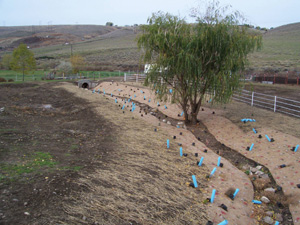 After Implementation (November 2005)
After Implementation (November 2005)
 New Banks: This photo, shot looking downstream following excavation, shows the newly sloped streambanks before erosion control fabric was placed. From this stage, the next step is to seed the bank with native grasses, then lay down fabric made of coconut fiber or some similar material to protect against erosion.
New Banks: This photo, shot looking downstream following excavation, shows the newly sloped streambanks before erosion control fabric was placed. From this stage, the next step is to seed the bank with native grasses, then lay down fabric made of coconut fiber or some similar material to protect against erosion.
 Fence Keeps Horses Out of Restored Area: This fence, installed in October of 2005, keeps horses out of Tammany Creek, thereby reducing pollution and erosion.
Fence Keeps Horses Out of Restored Area: This fence, installed in October of 2005, keeps horses out of Tammany Creek, thereby reducing pollution and erosion.
 Erosion Control Fabric (October 2005): Mike Danahy, a PCEI AmeriCorps member, installs erosion control fabric along newly shaped stream bank.
Erosion Control Fabric (October 2005): Mike Danahy, a PCEI AmeriCorps member, installs erosion control fabric along newly shaped stream bank.
 Newly Planted, But No Water Yet (November 2005): The state of the creek after several planting events. The creek, dry in this photo, will fill with water after winter snows melt. By spring, it will be flowing nicely.
Newly Planted, But No Water Yet (November 2005): The state of the creek after several planting events. The creek, dry in this photo, will fill with water after winter snows melt. By spring, it will be flowing nicely.
 Photo Point V4 Downstream March 2005
Photo Point V4 Downstream March 2005
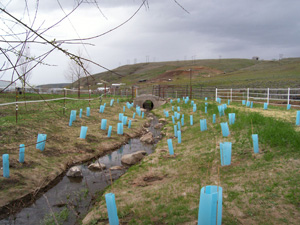 Photo Point V4 Downstream (April 2006)
Photo Point V4 Downstream (April 2006)
 Photo Point V4 Upstream (March 2005)
Photo Point V4 Upstream (March 2005)
 Photo Point V4 Upstream (April 2006)
Photo Point V4 Upstream (April 2006)
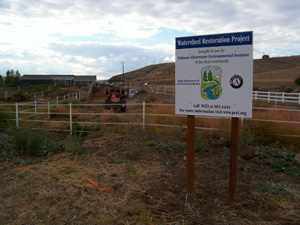 Signage: This sign faces the road from the restoration site, letting the public know about restoration efforts on Tammany Creek. Restoration funds are provided by Idaho Department of Environmental Quality. Educational activities for 2005 are funded by New Priorities Foundation, Idaho Learn and Serve and the Evergreen Foundation.
Signage: This sign faces the road from the restoration site, letting the public know about restoration efforts on Tammany Creek. Restoration funds are provided by Idaho Department of Environmental Quality. Educational activities for 2005 are funded by New Priorities Foundation, Idaho Learn and Serve and the Evergreen Foundation.
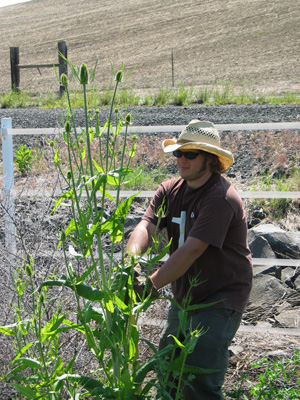 Randy Tackles Teasle: Nonnative weeds dominate the site. PCEI AmeriCorps members spent time weeding during the summer.
Randy Tackles Teasle: Nonnative weeds dominate the site. PCEI AmeriCorps members spent time weeding during the summer.
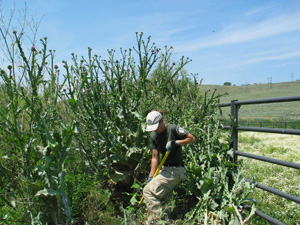 Weeding Thistle (Summer 2005): AmeriCorps and student volunteers worked together to remove thistle prior to restoration.
Weeding Thistle (Summer 2005): AmeriCorps and student volunteers worked together to remove thistle prior to restoration.
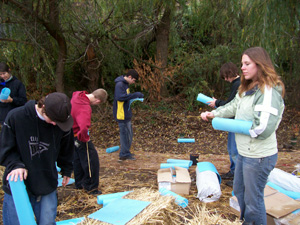 Ah… Blue Tubes! Volunteers help prepare for the Tammany Creek Education Event by assembling blue tubes.
Ah… Blue Tubes! Volunteers help prepare for the Tammany Creek Education Event by assembling blue tubes.
 Teach the Children Well (November 2005): PCEI AmeriCorps member, Mike Danahy, instructs Lewiston 1st graders from Centinneal Elementary School. PCEI sponsored three days of education opportunities for local students. One of the goals of PCEI is to connect students to their watersheds through hands on learning activities such as tree planting. The Evergreen Foundation and New Priorities Foundation sponsored the education component of the event November 2005.
Teach the Children Well (November 2005): PCEI AmeriCorps member, Mike Danahy, instructs Lewiston 1st graders from Centinneal Elementary School. PCEI sponsored three days of education opportunities for local students. One of the goals of PCEI is to connect students to their watersheds through hands on learning activities such as tree planting. The Evergreen Foundation and New Priorities Foundation sponsored the education component of the event November 2005.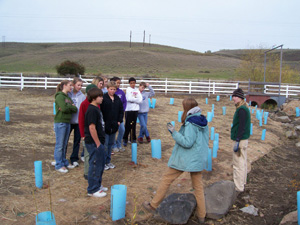 7th Graders and 700 Trees and Shrubs (November 2005): The entire 7th grade from Jennifer Junior High came to Tammany Creek to learn about stream restoration. The large group helped PCEI AmeriCorps members and staff plant over 700 plants during the three day Tammany Creek Education Event in November 2005. Here, Americorps member Emily Poor (in blue jacket) talks with the students.
7th Graders and 700 Trees and Shrubs (November 2005): The entire 7th grade from Jennifer Junior High came to Tammany Creek to learn about stream restoration. The large group helped PCEI AmeriCorps members and staff plant over 700 plants during the three day Tammany Creek Education Event in November 2005. Here, Americorps member Emily Poor (in blue jacket) talks with the students. Sea of Blue Tubes (February 6, 2006): Many blue tube plant protectors mark some of the plants that have been placed on Tammany Creek by PCEI staff and volunteers.
Sea of Blue Tubes (February 6, 2006): Many blue tube plant protectors mark some of the plants that have been placed on Tammany Creek by PCEI staff and volunteers.
 Bazillions of Tadpoles!!! (2006) Look closely. See all those little things swimming around? Tadpoles. See that thick band of brownish black near the bottom of the image? Bazillions more tadpoles!! That’s right, Tammany Creek was the place to be for tadpoles during the 2006 metamorphic season.
Bazillions of Tadpoles!!! (2006) Look closely. See all those little things swimming around? Tadpoles. See that thick band of brownish black near the bottom of the image? Bazillions more tadpoles!! That’s right, Tammany Creek was the place to be for tadpoles during the 2006 metamorphic season. After Tadpoles, Spotted Frogs: Later in the season, these critters were seen quite a bit about in their Tammany Creek stomping grounds. Besides frogs, salamanders are not uncommon to see near the creek.
After Tadpoles, Spotted Frogs: Later in the season, these critters were seen quite a bit about in their Tammany Creek stomping grounds. Besides frogs, salamanders are not uncommon to see near the creek.
 Stinger and Willow Poles (March 2006): Americorps members Emily Wolf and Charles Dickey work together to plant willow poles. The poles are transplanted saplings that have been submerged for several weeks in water, which helps them grow roots. Emily uses the “stinger” to inject pressurized water into the ground, which creates a pole-sized hole. Charles follows behind her, plugging the holes with the young willows.
Stinger and Willow Poles (March 2006): Americorps members Emily Wolf and Charles Dickey work together to plant willow poles. The poles are transplanted saplings that have been submerged for several weeks in water, which helps them grow roots. Emily uses the “stinger” to inject pressurized water into the ground, which creates a pole-sized hole. Charles follows behind her, plugging the holes with the young willows.
 Pond (Early 2006): This pond was created in early 2006 to catch water in the pasture. Wetland plants, including trees, shrubs, rushes, and sedges, were added in the spring. The tadpoles loved this pond (the bazillions of tadpoles photograph was taken here).
Pond (Early 2006): This pond was created in early 2006 to catch water in the pasture. Wetland plants, including trees, shrubs, rushes, and sedges, were added in the spring. The tadpoles loved this pond (the bazillions of tadpoles photograph was taken here).
 Watershed Festival Tree Planting (November 1, 2006): Americorps member Emily Wolf helps two students plant a tree during the Tammany Creek Watershed Festival. Fifth and first graders from Lewiston came to Tammany Creek for the educational event, which also featured learning stations on water resources, wildlife, and the food web.
Watershed Festival Tree Planting (November 1, 2006): Americorps member Emily Wolf helps two students plant a tree during the Tammany Creek Watershed Festival. Fifth and first graders from Lewiston came to Tammany Creek for the educational event, which also featured learning stations on water resources, wildlife, and the food web.
 Salamander!! Former PCEI Americorps member and current volunteer Denim Jochimsen entertains and educates students at the wildlife station during the Tammany Creek Watershed Festival. Live wildlife included a rubber boa constrictor as well as this salamander.
Salamander!! Former PCEI Americorps member and current volunteer Denim Jochimsen entertains and educates students at the wildlife station during the Tammany Creek Watershed Festival. Live wildlife included a rubber boa constrictor as well as this salamander.
